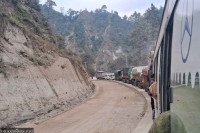Opinion
Lousy growth
The rate of return on investment in information technology in Nepal continues to be on the lower side
Vivek S Rana
Organisations today have been investing in information technology (IT) as never before. In fact, IT spending continues to be the single largest element of capital investment for many enterprises. In the Nepali business world, a cluster of computer and telecommunications technologies is playing much the same role that national highways, railroads and new factory modes of production did in the beginning of the 20th century. The current wave of IT-enabled change appears, however, to be just the beginning. The expected long-term impact of information technology is routinely compared to such technologies as electricity, the internal combustion engine, the printing press and even the wheel. However, realising business benefits from IT-supported projects in Nepal continues to be a major challenge.
At the moment, however, there is a big practical problem. The track record of information technologies to date is uneven, and it is hard to figure out what makes a successful IT investment. This is especially true in the Nepali context where the underpinning infrastructure such as electricity, internet bandwidth and connectivity still remains unstable, poor and unreliable. At the heart of the problem is a fundamental change—how organisations are using information provided by that technology.
The management perspective
The early applications of IT were primarily in automation of routine work, an extension of industrial-age mechanisation. Unfortunately, the move from the simple implementation of IT to an age of IT-enabled change is taking place very slowly because of the lack of an accountability framework in the management of IT, causing business units to transfer all the risks to the IT department. The management often finds itself clueless about the business requirement of IT. Thus, it develops a cost view rather than a value perspective towards information technology.
While the application of technology has evolved, and as its impacts have become far more dramatic, our management mindsets have somewhat failed to keep pace with it. Most of the management thinking is still rooted in industrial-age mentality of work automation, with its clear and predictable benefits, requiring little more than the plugging in of the technology for results to be achieved. This is a far cry from the challenges present today where the benefits are neither clear nor easily predictable.
The good and the bad
Taking a quick bird’s-eye view of how information technology in Nepal has been applied in the business world, what we see is the ‘best of times’ and the ‘worst of times’. At the best of times, IT works productivity miracles and produces logistical breakthroughs, and it has basically transformed telecommunications, banking, payment systems and, to some extent, retail distribution. At the worst of times, IT falls down on the job, disastrously. Most visibly, and to many people’s embarrassment, when banking systems miscalculate applied interest, when one’s credit card penalties are prematurely applied or when customers cannot recharge their mobile device or when a system does not generate your telephone bill on time. Ironically, in all such cases in Nepal, whether it is the bank, or the telecom company or a utility service provider is the key stakeholder, the customer for whom the systems are primarily implemented are the ones penalised for someone else’s mistake.
Less visible, but far more important in economic terms, are many cases where perfectly good technology has been poorly applied to business problems. Examples include the recent implementation of the know your customer forms for commercial banks that was mandated by the central bank requiring a significant redesign of the banking application interface, and the Nepal Telecom billing system often requiring over three minutes during peak hours to churn out the billing data, which often leaves the processing clerk behind the payment counter frustrated and forced to smile and say, “Ask IT.”
Finally, there is the grey area of information technology, a large basket of everyday problems that fall between the best and the worst. A perfect example is the mundane but expensive technology that is not used or missed. People do not know and are not effectively taught how to use software interfaces and information systems. Often, they do not understand what to do with the information that they provide. Furthermore, the requirement of both manual and electronic processing in government service delivery operations is pushing up per transaction costs for service recipients. This is further increasing operational risks by providing zero value to service providers.
Waste of money
Many service providers point their fingers at inadequacies in the legal system to deal with electronic transactions; but due to lack of service provisioning for the future, the replacement process will incur significant costs or most likely kill the project. Nepal has continued to see an influx of foreign aid money for national service delivery efforts, most of which, for similar reasons, have failed to take off or will never do. What has often been ignored by donors is that the governance of IT is similar to the governance in development.
The current IT scorecard for Nepal is not bad-bad. There has definitely been some improvements, however, the rate of return in terms of IT investment continues to be on the lower side making IT projects and benefit realisation uncertain, highly risky, and to a large extent, uncontrollable. Given the fact that over 80 percent of the technology used is the generic plug and play model, information system deficiencies will never surface without third party assurance. And services will continue to deteriorate leading to organisations and the government throwing good money after bad. As a result, expensive new technologies and intelligent software continue to sit on people’s desktops, producing zero, or worse, negative economic value while they learn what to do with it. Time is lost; and in most cases around the world, lost time means lost money.
Rana is an IT governance and risk management professional




 5.14°C Kathmandu
5.14°C Kathmandu












